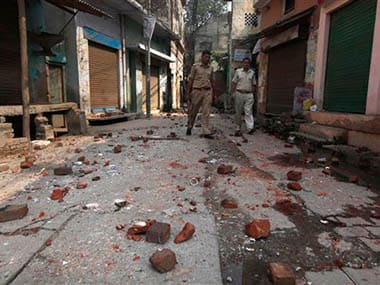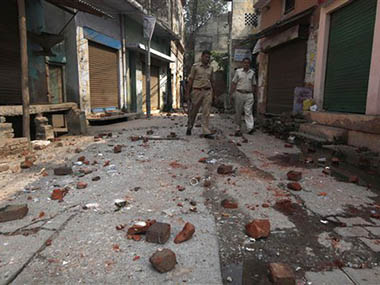Till about 10 days back, Muzaffarnagar did not have a history of communal tension. Jats and Muslims, the two numerically dominant and socially influential communities, lived fairly peacefully. Even their voting preferences have broadly been the same in most elections. But the communal tension that began with a rather small, if not entirely trivial, issue on 27 August, has changed everything. The Muzaffarnagar riots are one more statistic in the 50-odd mini riots that have taken place under the watch of Akhilesh Yadav in Uttar Pradesh since he was elected last May. The most unfortunate part, apart from the fact that so many people were killed, is that the riots spread to rural areas. The intensity of animosity appears to be much stronger than initially anticipated and the riots lasted much longer than they would usually have in urban areas. The death toll, according to official figures, is 31, but the locals suspect that the actual number of dead may be much more. There are many youth missing from both communities, and nobody is in a position to comment on their fate. Several of them have fled to find security elsewhere, but there are also apprehensions that some of these ‘missing’ may well be dead. [caption id=“attachment_1095871” align=“alignleft” width=“380”]  Police walk on a road scattered with bricks and stones thrown during a communal clash in Muzaffarnagar on September 9. AP[/caption] That Akhilesh Yadav has not been upto the task of handling the riots is clear, but the fact that they are happening in the run-up to the next parliamentary elections indicates that they may have a political dimension. All the political parties concerned are, in fact, weighing the consequences. The Samajwadi Party is blaming the BJP and the Bharatiya Kisan Union (BKU) for creating the trouble because some of their leaders participated in a condolence meeting-cum-panchayat held on 31 August, organised in protest against the brutal lynching of two boys who had gone to a Muslim-dominated village to warn against a supposed relationship between a Muslim boy and a Jat girl. In the meanwhile, a Muslim youth was killed in retaliation, according to one version of events. The local panchayat then decided to call a Mahapanchayat on 7 September at Nagla Mandaur, near Muzaffarnagar. The problem escalated from there. The state administration knew of the communal tensions. Even Union Home Minister Sushilkumar Shinde has gone on record to say that his ministry had cautioned the UP government about the likely communal flare-up. The administration issued prohibitory orders and imposed Section 144. It was at the Mahapanchayat that some inflammatory speeches were made and some victim accounts narrated. Over one lakh people from the neighbouring districts, including some from Haryana, had gathered. The confusion started from here. According to some local accounts, the Muslims of the locality thought that the Jats had all gathered with a purpose and were returning with a vow to take revenge in their respective areas. Some of them, goes one version of events, then decided that offence was the best form of defence and attacked those returning from the Mahapanchayat. Several persons were killed and more were injured. An influential Muslim leader, who also has business interests in the area, told Firstpost that unlike other parts of the state, the economic conditions of Muslims in this area are relatively better, but this kind of aggression has never been seen. “It looks as though some outside influence has been working here. We can’t say who and what, but the most unfortunate part is that this will leave a scar that is not going to be healed in years to come. Since the violence has originated from rural areas and rapidly spread to the hinterland, we fear for what may happen after the army is removed and as we move closer to the elections.” Asked how this incident will impact the coming Lok Sabha elections in a state that sends 80 MPs, he spoke of something that was very interesting from a Muslim political perspective. “In all riots and riot-like situations, Muslims face the brunt. Very often, the police target the younger members, bringing total gloom in the community. But this time the clash was between two communities. The police and the army have brought the situation under control, without specifically targeting the minority community. The Samajwadi government has been fair in dealing with the situation even as it proved to be incompetent in containing the communal flare-up at the outset.” He and others blame it on the Mahapanchayat. Why was it allowed to happen when Section 144 was imposed? Couldn’t it have been stopped like the government had stopped the Chaurasi kos Yatra of Hindu saints in Ayodhya? But then it appears that the ruling Samajwadi Party, despite all-round criticism, is holding its ground in its core social constituency. This region is in the influence zone of RLD leader and Civil Aviation leader Ajit Singh, who inherited the Jat votebank from his father, Chaudhary Charan Singh. The RLD, which contested the 2009 parliamentary elections along with the BJP, won five Lok Sabha seats but switched sides to contest the 2012 assembly elections with the Congress. The RLD won nine assembly seats. In the recent communal violence, the Jats appear to have been at the receiving end. There are early indications that the riots may cost Ajit Singh’s RLD and the Congress dearly, assuming the two contest the 2014 parliamentary polls together. Mayawati has come out strongly against the Akhilesh government. The BSP and the Congress have one point in common – they claim that it was a fixed match between the SP and the BJP, since a polarisation is said to benefit both of them. While the veracity of their charges can never be ascertained, if a polarisation does happen, it could put the Congress and the BSP out of the reckoning for Muslim votes, at least in substantive chunks. If that happens, then it could well turn out to be a Samajwadi versus BJP fight in Uttar Pradesh. With Modi set to become the face of the BJP in the 2014 elections and his protégé, Amit Shah, being put in charge of the Uttar Pradesh campaign, there is already a Hindutva undercurrent. This got a further push following the Samajawadi Party’s pro-minority tilt and announcements of various kinds. The BJP is officially making very restrained and legally compatible comments. It knows that any over-the-top position will affect its credibility. But it is asking why no names of Samajwadi Party leaders have cropped up in the riots. As per the SP’s organisational structure, party strongman Azam Khan has supervisory control of the districts. Off the record, some BJP leaders are asking questions on the community-wise break up of the persons who have been arrested or accused of instigating the riots. As 2014 nears, one can expect the tensions to continue simmering.
The Muzaffarnagar riots in Ajit Singh’s backyard may be setting the backdrop for the communal polarisation in 2014.
Advertisement
End of Article


)
)
)
)
)
)
)
)
)



